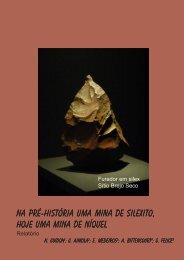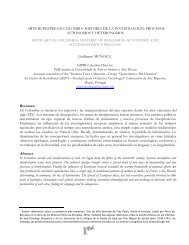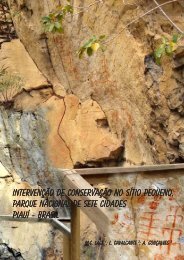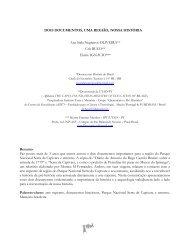Untitled - Fundação Museu do Homem Americano
Untitled - Fundação Museu do Homem Americano
Untitled - Fundação Museu do Homem Americano
You also want an ePaper? Increase the reach of your titles
YUMPU automatically turns print PDFs into web optimized ePapers that Google loves.
Aesthetics and Ethics in rock art of the transition into farming<br />
Luiz Oosterbeek & Guillermo Muñoz - Portugal, Colômbia<br />
Rock art studies have been conducted, mainly under two major approaches: on one hand the identification<br />
of styles and motives; on the other the focus on techniques and places. Curiously, with few exceptions<br />
(including the series of seminars on Rock Art and Aesthetics that includes the present session), fewer<br />
considerations are to be found in terms of aesthetics. Yet, when Henri Breuil drew a parallel between<br />
Altamira and the Sistine Chapel he was valuing more than the symbolic role of the space, he was<br />
looking at the newborn rock art as…art. And he did so, being an artist as well as an archaeologist,<br />
from an aesthetic perspective, recognising such “capacity” in prehistoric people, largely a denial of the<br />
evolutionary Hegelian approach to aesthetics. In this paper, we attempt to review the evolution of the<br />
concept of rock art in its relation to aesthetics (perception and sensation, poieisis) and but also to ethics<br />
(character and traditions). In fact, rock art in the transition into farming, in various contexts, seems to<br />
proceed from implicit rules (not necessarily nomoi) that may be better understood in the context of ethics<br />
than of their aesthetic dimension.<br />
(Artigo 51 IFRAO2009)<br />
Canadian Shield rock art: aesthetics of place and landscape<br />
Dagmara Zawadzka, Canadá<br />
60<br />
Thousands of red ochre images and hundreds of carvings grace the cliffs and outcrops of a vast territory<br />
stretching from Québec to Saskatchewan. Aesthetic qualities in Canadian Shield rock art have rarely<br />
been addressed as scholars were especially preoccupied with elucidating the meaning of the images<br />
and their age, while coming up with ways to preserve them. However, Canadian Shield rock art offers<br />
a great potential for study as an aesthetic phenomenon. The ethos of a holistic approach to existence<br />
espoused by North American Indigenous people is reflected in their aesthetics where forms of visual<br />
expression are fully realized when being part of an embodied performance with spiritual connotations,<br />
where the functional and the beautiful co-exist. The aesthetic value of rock art is apprehended within its<br />
landscape context, where rock art can be experienced and where it can fulfill itself ritually. The aesthetic<br />
experience of rock art stems from the location of the images within the landscape, thus the properties of<br />
the surrounding landscape, as well as those of the rock outcrop (such as quartz veins and calcite/ silica<br />
precipitate deposits), as well as from the visual and acoustic properties encountered at the sites (such<br />
as shimmering light reflecting from water surface onto the cliffs or echo effects). All these characteristics<br />
possibly carry spiritual associations and enhance the ritual potential of rock art sites while creating an<br />
impact on those who view and experience the art.<br />
(Artigo 52 IFRAO2009)<br />
The White Lady of the Deighton<br />
Margaret Bullen , Austrália<br />
Unlike the White Lady of the Branderg the lady of the Deighton, in South East Cape York, is both white<br />
and female. An arresting figure, protected by rugged terrain and a jagged jumble of rocks, she holds centre<br />
stage in a difficult of access cave. She both bridges a cleft in the rock and is defined by it. She is both<br />
on and within the surface of the cave. She is not large or brightly coloured yet she commands attention.<br />
Perhaps it is because in this lonely place she has only a dingo for company or perhaps it is the hand<br />
print on her body which implies a power within her sought by others. She has been painted more than<br />
once, not in another part of the cave but reworked along the same break in the skin of the rock. Is she<br />
more pleasing to the eye because she is so hidden and is suddenly revealed or because of the innate<br />
symmetry of her image and its appeal to the imagination. This paper will explore ways in which the Lady<br />
of the Deighton seduces her visitors and yet remains as enigmatic as the Mona Lisa.<br />
(Artigo 53 IFRAO2009)<br />
FUMDHAMentos IX

















